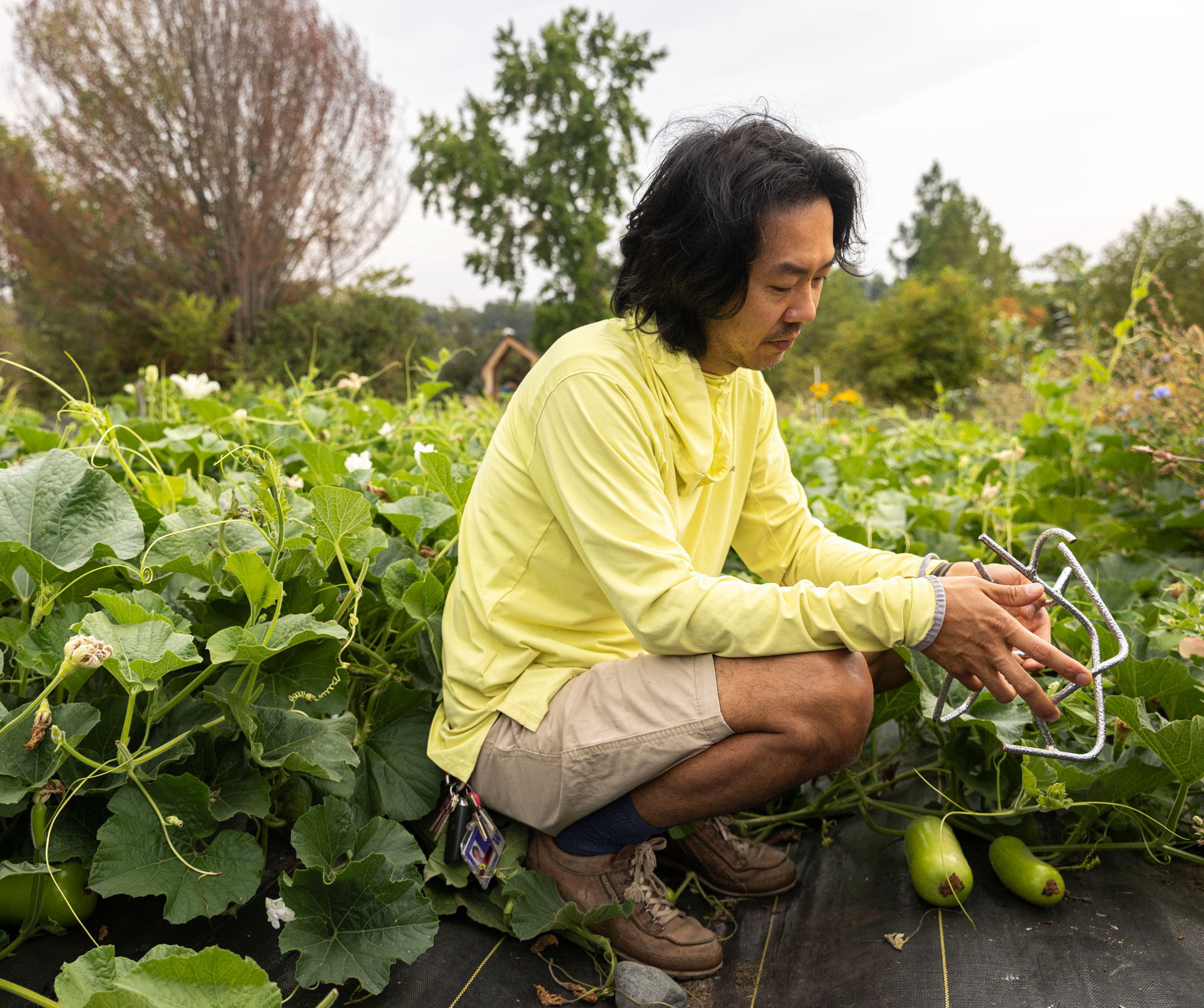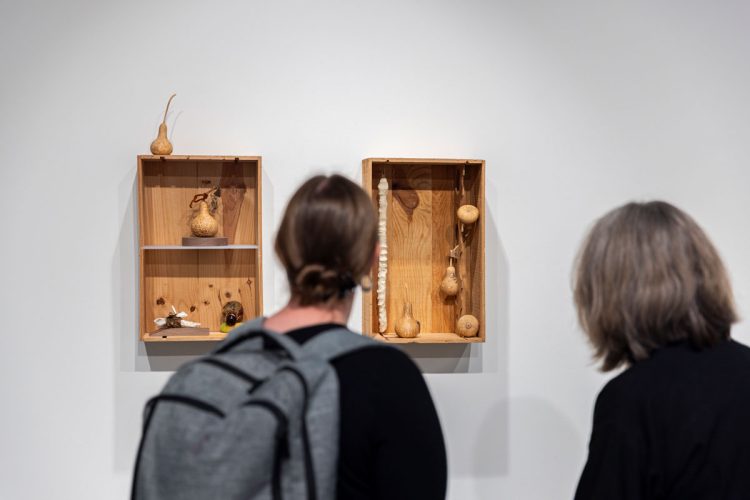Autumnal Alchemy Autumnal Alchemy Autumnal Alchemy
Rob Rhee's eerie gourds blur the lines between nature and art.
By Shin Yu Pai | Photos by Mark Stone | Viewpoint Magazine

As the fall season settles over Seattle, the fields at the UW Farm have taken on a peculiar kind of magic. Amid curling vines and the hardening of ripening gourds and squash, strange hybrid forms in wire cages are swelling—part nature, part man-made bricolage.
It’s a scene straight out of Mary Shelley’s “Frankenstein”: A living experiment of creation and control. In the hands of UW assistant professor Rob Rhee, a gooseneck gourd becomes both object and accomplice, coaxed into a supernatural new body through metal cages and grafted vines.
Rhee’s recent exhibition, “Crossings,” at the Jacob Lawrence Gallery, convoked newly completed bricolage sculptures from his studio along with research he began last spring at the UW Farm. The objects on view echoed his early experiments with living plant material. For several years, Rhee has worked alongside farmers to grow gourds from seed, training the fruit within metal cages to produce unexpected and often haunting new forms. His once-living sculptures have appeared at venues including the Frye Art Museum and the Portland Art Museum.
“I’m often drawing from materials and processes in everyday life when making my work,” Rhee says. “The trivial, mundane and overlooked are often given special attention in bricolage, which often contrasts it with the more monumental associations people bring with them, when they hear the word ‘sculpture.’ Bricolage centers the practice in an act of rebuilding,” he says. “It’s a quest for coherence, a kind of puzzling with what you’ve got. A scrappy practice where, ideally, the energy of searching is present in the resolution.”
Rhee assembled several sculptures in “Crossings” from broken shards of gourd salvaged from the growing and harvesting process. “Untitled (Sledge),” for example, conjures the unsettling forms of the Surrealist Hans Bellmer, who was known for his photographs of fragmented and reassembled dolls. Rhee’s work also gestures toward Joseph Cornell’s box assemblages and the Korean “chaekgori”—cabinets of curiosity showing off found scholar’s rocks and other organic forms Rhee gathered from nature.
Rhee worked with glass artist Granite Calimpong, ’19, to create “Gist Translation,” glass vessels emulating gourd forms. Calimpong blew molten glass into gourds that were then used to store nutrient-rich liquid that he fermented from plant cuttings, transforming the waste into a nourishing brew to be fed back into the soil.
“The recipe for these fertilizers comes from a subset of Korean Natural Farming called JADAM,” Rhee says. It involves “fermenting parts of the plant in water, with some fungi–infused soil and then adding the fermented liquid back to the plant during watering.” He learned the technique during a volunteer work session at the UW Farm. It was “a wonderful bit of serendipity. It really captured my imagination, this idea of aiding nature’s cyclical processes, instead of interrupting or controlling them.”
When people think of farming today, they often imagine industrial machines tilling the land and chemical fertilizers and modified seed, Rhee says. But this is just a strange sliver in the long story of agriculture. There is a much richer, more accessible history of practices like using tidal flows to till soil in tide flats, fungi to break down organic matter, and small interventions by insects, microbes and people.
Taking further inspiration from trees that naturally fuse together into hybrid bodies, Rhee’s latest work with gourds at the UW Farm experiments with grafting as a physical process for creating new sculptural possibilities. The resulting plants have strange, joined-together vines from multiple gourd varieties.
Rhee’s art has been exhibited at White Columns, New York; Fort Worth Contemporary Arts, Texas; and the Korean Cultural Center, Los Angeles. He has also exhibited internationally at the 10th Berlin Biennale and the Ilmin Museum of Art, South Korea. A Yale University graduate with an MFA from Columbia University, he currently serves as an assistant professor and chair of the Interdisciplinary Visual Art program in UW’s School of Art + Art History + Design.

The sculptures in “Crossings” were shown alongside a reading shelf containing books that were influential to the artist, while putting his show together. “Jordan Jones, director of the Jacob Lawrence Gallery, and I were talking about how to continue the Jake’s practice of making reading materials available to viewers in dialogue with the exhibition,” Rhee says. “I had been working on these enamel experiments with the hope of putting some in the show but the colors didn’t quite match the brewing, brooding warm browns and bright yellow greens of fermentation around the show. Instead, I had these slivers of copper that I imprinted with field samples from the farm (weeds, leaves, seeds) that I think of as being a direct marker of all the work taking place at the farm, but not as an image as much as an artifact.”
Now, as Rhee prepares for his next exhibition with curator Derek Franklin at SE COOPER in Portland in August 2026, he continues to root his artistic practice in the fertile juncture between nature and experiment. Like Frankenstein’s creature, Rhee’s strange creations will continue to be a dialogue between growth, decay and transformation.

